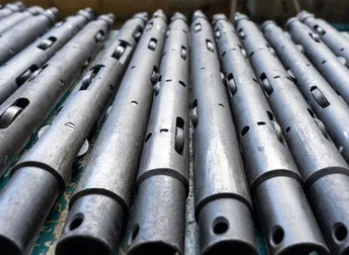In oil and gas exploration, the term wireline broadly defines industry-specific methods, processes, and technologies that lower cables and wires into a wellbore. Wirelines are strong, thin lengths of wire or braided cable mounted on a powered reel. Typical wireline applications affix “logging tools” or instruments to a cable rigged to drilling platforms or trucks that, once attached, is lowered by the cable into oil well holes or natural gas reservoirs to perform diagnostics or to gather and transmit data. As a general descriptive term, wireline is also used interchangeably to describe the processes, techniques, cabling technologies, and systems used to conduct wireline operations.
What is Wireline Used For?
 As it relates to industry activities, wireline activities are vital for oilfield operations and are essential to oil and gas exploration. The efficiency of upstream operations relies heavily on information gathered through wireline tools and technologies during drilling operations or production activities.
As it relates to industry activities, wireline activities are vital for oilfield operations and are essential to oil and gas exploration. The efficiency of upstream operations relies heavily on information gathered through wireline tools and technologies during drilling operations or production activities.
During completion and production operations, wireline field operators regularly perform wireline processes ranging from basic downhole directional surveys to firing perforated charges at precise locations. From compiling sensitive gamma ray formation logs to recovering a pipe or wrench in the borehole, and even managing and manipulating subsurface flow controls and well pressure – all are achieved through wireline operations.
Principles of Wireline Logging
Wireline applications that measure the properties and characteristics of wells and properties is referred to as well logging or more commonly, wireline logging. Wireline logging lowers sensors into boreholes on a cable rig to gather data through several methods, such as electromagnetic measurements or via acoustic wave measurements. The technique of conducting surveys to determine geological and mineral formations was developed in the 1920’s by brothers, Conrad and Marcel Schlumberger. Their very first electrical survey was a “well log” performed in 1927 at the Pechelbronn Oil Company oil field in France.
Their well logs measured electrical resistivity of geological formations deep within boreholes. The Schlumbergers’ understood that resistivity is a fundamental property of any given material and, consequently, that property determines how strongly that material will resist the flow of electric current. As rocks and sediment are natural electrical insulators, and fluids enclosed within them are electrical conductors, by taking electrical surveys within a borehole, its hydrocarbon bearing formations could be estimated. Resistivity values gathered from wireline logging provides indispensable data to evaluate formations in drilling for oil and gas.
Modern Wireline Logging Applications
Today, wireline logging measures not just resistivity, but conductivity, temperature, and can determine wellbore dimensions, hydrocarbon formation pressure, and temperatures. With the advances and technological developments in logging tools, wirelines can also measure a wide range of properties within the borehole—acoustic, electromagnetic, radioactive, and many others, allowing engineers to thoroughly evaluate formations and their potential for further exploration.
Well Logs
Raw data is acquired and recorded in an electronic format at the surface or directly in the borehole. It can be digitally filed for printing or a “well log” can be readied quickly for electronic transmittal. Wireline logging provides real time data on formations that have been penetrated by borehole operations, and when the well total well depth has been reached and its whole depth logged.
Workovers and Interventions
Wirelines are used in well workover and interventions, too, for the purpose of prolonging, restoring, or boosting production. After a well has been killed, for example, workovers remove and replace production tubing strings. In general, workovers perform a variety of invasive techniques that include major maintenance, remedial treatments, or such well intervention that may require explosive charges to fracture rocks, expand fissures, and open new channels to wellheads. Referred to as well perforation, such intervention jobs are used in both land and offshore operations. Wirelines run perforating guns to punch holes into the casings of oil wells. The action connects the wellbore to the reservoir, allowing reservoir hydrocarbons to flow freely into a wellbore. With today’s advanced software modeling and hardware, engineered perforating systems can be utilized to run on wirelines for a wide selection of other explosive devices, improving efficiency and reducing rig cost and time.
Wireline operations fulfill a variety of purposes in oilfield operations as well as in the exploration of gas and oil. Wireline cabling systems are designed to lower a variety of devices such as plugs, gauges and valves into boreholes, or retrieve piping or equipment. Wiring is also used in the transmission of electronic signals that provide real time data on subsurface formations. Throughout the phases of production and exploration, engineers look to wireline operations to provide valuable information and data regarding well diagnostics, intervention needs, change zone operations, and well perforation that allow reservoir hydrocarbons to flow freely into a wellbore. Overall, wirelines are essential to the oil and gas industry.


